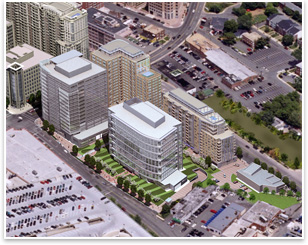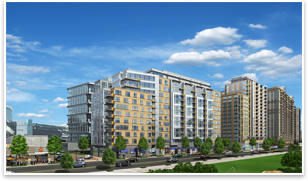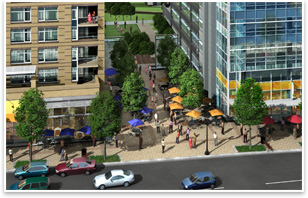LEED for Neighborhood Development Sustains the Places in Between Spaces
In advance of its public launch, the USGBC’s newest sustainability rating system opens itself to public comments
by Zach Mortice
Associate Editor
 Summary: LEED® for Neighborhood Development is the USGBC’s newest sustainability rating system. It measures the sustainability of entire neighborhoods, emphasizing broad issues of site context, infrastructure, programmatic use patterns, and social collaboration, as opposed to previous building-scale sustainability rating systems that are primarily concerned with the application of certain sustainability systems and practices. Currently in a pilot testing program, it will undergo a public comment phase in November before being released to the public in July of 2009. Summary: LEED® for Neighborhood Development is the USGBC’s newest sustainability rating system. It measures the sustainability of entire neighborhoods, emphasizing broad issues of site context, infrastructure, programmatic use patterns, and social collaboration, as opposed to previous building-scale sustainability rating systems that are primarily concerned with the application of certain sustainability systems and practices. Currently in a pilot testing program, it will undergo a public comment phase in November before being released to the public in July of 2009.
The U.S. Green Building Council’s LEED for Neighborhood Development (ND) certification system is the first sustainability rating system to address the goals of a sustainable built environment on an urban scale. Currently in a pilot program, LEED ND will go into a 45-day public comment period starting November 17 before officially launching to the public in July of 2009.
Essentially, LEED ND takes LEED’s previously established system of checklists detailing individual sustainability practices for individual buildings and applies it to the urban development goals of mixed-uses, pedestrian-friendly streetscapes, dense infrastructure development, public transit orientation, and active and passive energy saving measures.
But the program is about more than building individual buildings that are more sustainable, no matter how many are built. It’s about how buildings relate to each other as urban connective tissue, and it’s about how people relate to each other in sustainable communities. “This is really about the spaces between the buildings,” says Bert Gregory, FAIA, the vice chair of the LEED ND core committee and president and CEO of Mithun in Seattle. “It’s relating neighborhoods to larger ecological systems.”
 Growing in the right place Growing in the right place
LEED ND has been in development since 2002 and is a joint project of the USGBC, the Congress for New Urbanism, and the National Resources Defense Council. These three groups populate the program’s core committee with five members each. The core committee does much of the policy work of developing the rating system, and they’re aided by a larger group called the corresponding committee, which provides additional feedback and suggestions via a listserv. The program is currently being tested in 238 pilot projects in 39 states and 6 countries. The size of these developments range from a fraction of an acre to thousands of acres. Twelve pilot programs (including the Olympic Village in Beijing) have been certified with LEED ND so far, and most of the pilot projects exist in or near large cities to take advantage of the inherent sustainability bonuses of density and proximity to public transportation.
Similar to previous LEED rating systems like New Construction or Commercial Interiors, LEED ND gives architects a binary checklist of sustainable systems and practices to attain for points. The more points each project earns, the higher its rating, from Standard/Certified, Silver and Gold to Platinum. Like LEED for New Construction, LEED ND will be based on the ASHRAE 90.1 energy modeling standards. This standard uses fictionally averaged computer modeled buildings that set minimum energy performance baselines to which architects can compare their more energy efficient buildings.
Besides moving from building-scale rating systems to an urban-scale rating system, the program’s creators say that its framework is much the same as other LEED systems. Sophie Lambert, the USGBC’s director of LEED ND, says her organization wanted to maintain LEED’s “brand identity” and its status as an independent third-party rated system.
The LEED ND point checklist is primarily divided into three main categories, which are broader than the resource- and practice-specific categories attached to other LEED systems, like water efficiency, energy and atmosphere, and materials and resources. Because LEED ND works on an urban, neighborhood scale, it strongly emphasizes prerequisite site conditions for development.
A handful of points is available in the Innovation and Design Process category, which are flexible and can be adapted to various design and sustainability priorities.
The first large category is called Smart Location and Linkage and deals with fundamental site planning and context issues. It includes points and prerequisites for protecting sensitive sites like farmland and locations of endangered species. Eight points are available for reduced automobile dependence offset by more public transportation. LEED ND awards points for grouping homes closer to jobs, schools, and retail in a way that encourages residents to walk. Gregory says the category “makes sure growth is placed wisely.”
 Growing the right way Growing the right way
The category with the largest point total (39) is called Neighborhood Pattern and Design. It deals with general infrastructural development and design, like designing densely populated residences with walkable streetscapes. It also looks at the social engineering role of sustainable development by encouraging the productive collaboration of groups with different incomes and development roles. Mixed uses are rewarded, as well as local food production and reduced parking lot footprints.
There are also two points for making affordable housing available. Lambert says this is part of the USGBC’s mandate for encouraging social equity and the recognition that a mix of different people with different income levels and work habits create more vibrant, active, and functional neighborhoods has been much overlooked in the years since 1961, when Jane Jacobs mentioned it in The Death and Life of Great American Cities. There’s also one point available in this category for “community outreach and involvement,” which will reward architects and developers who engage the communities they are building for in a dialogue about their project through town hall meetings, community forums, or public charrettes.
“In order to have successful developments that are accepted at the community level, you really need to engage them at the start, so it’s not just engaging public officials, it’s engaging local community groups,” Lambert says.
Building a way of life
The final category is Green Construction and Technology, and it’s more typically in line with past LEED rating systems and the public’s idea of what sustainable architecture is. This is where individual sustainability practices and systems make their appearance: using recycled content, reduced water use, heat island reduction, infrastructure energy efficiency, and, of course, developments get points for having LEED certified buildings on-site.
Only two points are available for on-site renewable energy generation, like photovoltaic power or wind turbines. These point totals could be recalibrated before the official launch of LEED ND, but Gregory says the program is primarily interested in contextual sustainability issues and not individual building-by-building systems. With this, USGBC has deemphasized the primary emblems of sustainability in the public mind in favor of the formidable benefits of sustainable development methods that are much more a way of life (mixed uses, public transportation, etc.) than an isolated piece of infrastructure.
The Back Story
On May 28, leaders of the AIA and the U.S. Green Building Council signed a memorandum agreeing to develop a strategic alliance toward advancing the two organizations’ shared goals and complementing existing collaborative activities that include continuing education, research, and the AIA-coordinated 2030 coalition. Focusing in areas where there is already strong collaboration, the AIA and USGBC will create a strategic alliance and associated work plan in three main areas: advocacy, education, and research. Earlier in May, AIA and USGBC staff and volunteer leadership identified at least 10 possible collaborative projects, with prospects of more to be identified in the near future. The strategic alliance will include an annual leadership meeting, regular meetings between senior staff leadership, and existing efforts, such as reciprocal sponsorship of USGBC’s Greenbuild and the AIA’s annual convention. Click here to read a PDF of the memorandum, which was signed by AIA Executive Vice President/CEO Christine McEntee and USGBC President, CEO, and Founding Chairman S. Richard Fedrizzi.
|



